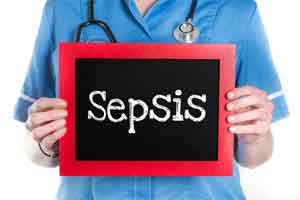- Home
- Editorial
- News
- Practice Guidelines
- Anesthesiology Guidelines
- Cancer Guidelines
- Cardiac Sciences Guidelines
- Critical Care Guidelines
- Dentistry Guidelines
- Dermatology Guidelines
- Diabetes and Endo Guidelines
- Diagnostics Guidelines
- ENT Guidelines
- Featured Practice Guidelines
- Gastroenterology Guidelines
- Geriatrics Guidelines
- Medicine Guidelines
- Nephrology Guidelines
- Neurosciences Guidelines
- Obs and Gynae Guidelines
- Ophthalmology Guidelines
- Orthopaedics Guidelines
- Paediatrics Guidelines
- Psychiatry Guidelines
- Pulmonology Guidelines
- Radiology Guidelines
- Surgery Guidelines
- Urology Guidelines
New computer-aided model may predict sepsis and reduce death risk

Sepsis is a major cause of death in hospitals, and early detection is key to preventing deaths. Every hour of delay is linked to a seven per cent reduction in survival, but delays in detection are common, according to the research published in the Canadian Medical Association Journal.
Keeping this in mind Researchers from the University of Bradford in the UK have developed a computer-aided model that may help predict sepsis by routinely collecting data to identify early symptoms of the life-threatening condition.
Sepsis is a potentially life-threatening condition caused by the body's response to an infection. The body normally releases chemicals into the bloodstream to fight an infection. Sepsis occurs when the body's response to these chemicals is out of balance, triggering changes that can damage multiple organ systems.
Sepsis is most common and most dangerous in:
- Older adults
- Pregnant women
- Children younger than 1
- People who have chronic conditions, such as diabetes, kidney or lung disease, or cancer
- People who have weakened immune systems
Several scores exist to help identify patients with sepsis, including the National Early Warning Score (NEWS) used in the UK's National Health Service hospitals.
Researchers developed the computer-aided National Early Warning Score (cNEWS) to determine if it could enhance the accuracy of predicting sepsis.
"The main advantage of these computer models is that they are designed to incorporate data that exist in the patient record, can be easily automated and place no extra burden on the hospital staff to collect additional information," said Professor Mohammed A Mohammed from the University of Bradford.
The cNEWS score can trigger screening for sepsis usually within 30 minutes of admission once routinely collected information has been electronically entered into the patient's medical record.
"These risk scores should support, rather than replace, clinical judgment. We hope they will heighten awareness of sepsis with additional information on this serious condition," Mohammed said in a statement.
Researchers said cNEWS may be introduced carefully into hospitals with appropriate information technology infrastructure and evaluated.

Disclaimer: This site is primarily intended for healthcare professionals. Any content/information on this website does not replace the advice of medical and/or health professionals and should not be construed as medical/diagnostic advice/endorsement or prescription. Use of this site is subject to our terms of use, privacy policy, advertisement policy. © 2020 Minerva Medical Treatment Pvt Ltd